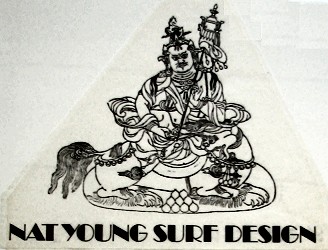
| home | catalogue | history | references | appendix |
 |
surfresearch.com.au
the catalogue
#341
|
| 1972 Barry Bennett - Nat Young Pintail 7 ft 6" |
#341
|

|
Length :
|
7
|
ft |
6
|
inches |
L2:
|
7ft 5'' |
|
Width :
|
20
|
inches |
Wide Point :
|
+ve 5
|
inches | |
|
Nose :
|
12
|
inches |
Tail :
|
10 .5
|
inches | |
|
Thickness :
|
3
|
inches |
Pod :
|
0
|
inches | |
|
Nose Lift :
|
inches |
Tail Lift :
|
inches | |||
|
Weight :
|
kilos |
Volume :
|
litres | |||
|
Other :
|
inches |
| FIN Left: 8' x 5.25" base x 9'' span @ 6.5''. Greenough Stage IV by Nat Young (Poor image). Right: Similar fin from #174 |

  |
| DECOR DECAL Deck: Oriental illustration and Nat Young Surf Design text at sweet spot in black and white. See decal laminates below. Bottom: BB (red?) diamond at nose. MARKINGS Deck: none Bottom: COLOUR Deck: white pigment with dark blue rail lap and black pinlines. Bottom:
dark blue pigment.
|
 |


In early 1971, Nat Young had
relocated to a rural acreage outside Byron Bay on the NSW North
Coast where he:
turned the property's old
farm-machinery shed into a surfboard factory, building the
glassing stands myself and, with Garth Murphy's help, a
shaping stand.
It was really satisfying
building boards at home; I did everything myself and there
were always plenty of orders, what with sales to a growing
number of local friends and Ray Richards, from Newcastle,
who asked me to make boards for his shop whenever I had time
between custom orders.
I modelled them on the board I
was riding at that time, a scaled-down version of those
Cabell had been surfing in Kauai; 7-foot long by 20 1/2
inches wide, a double-ended pintail with soft, low rails
tucked under to an edge.
I coloured them all in soft
pastels and used very small pivot fins, as with that design
I found that I didn't need to use much fin at all, the drive
coming from the bottom shape and low rails.
Over the course of twelve
months I kept reducing the fin size until I'd got it down to
only 7-inches deep and 3-inches wide at the base.
It was at this time that the footage of Nat at Broken Head was shot by Alby Falzon for inclusion in The Morning of the Earth, see below.
The design featured a compressed
pintail gun template, 2nd phase concave bottom, soft box rails
with a hard edge, large nose lift and a small Greenough single
fin.
The early models Byron Bay models
usually featured grey/blue pigment laminate and this was
continued when the boards were initially manufactured for
Bennett Surfboards in Brookvale.
Later Sydney models, first at
Bennetts and later at Nat's Mona Vale factory, had sprayed
blanks.
While the early models often had, as
on this example, one of several large Oriental decals
(see below), by the mid-1970s this was replaced by a large naked
female and floral illustration, see #151.
These design was manufactured,
virtually unchanged until 1981, thereafter it was reconfigured
by inverting the position of the wide point, widening the tail
and installing a tri-fin set up.
See Nat Young Tri fin # 57.
OTHER NAT YOUNG BOARDS
Pintails #20, #151 and #174
- images below.
Also see Nat Young Tri fin # 57, 1981 and Nat Young Tri fin # 27, 1981
COMMENTS : Replacement board for #20
REFERENCES
Magazine Article :
1. Falzon, Albert and
Murphy, Garth (Photographers) :"Nat and His Boards and His
Surfing"
Tracks October 1971, page 14.
Note Pintail and Squaretail (Backhand)
model.
2. Nat Young : ''Ten
Years in the Planning''
Surfing World Volume 26
Number 4 1978 pages 24 - 26
Photos by Bruce Channon, image below.
Books:
1. Nat
Youngís
Book of Surfing page 64.
2. Nat :
Surfing Fundamentals Pages 100 - 101.
Same text as # 1. above. Includes
reprint of Pintail/Backhand photograph in Magazines # 1, noted
above.
3. Natís
Nat
and thatís that
Extensive references and
photographs, note pages 228 to 236.
Film :
1. Alby Falzon: The
Morning
of the Earth, 1972.
http://www.youtube.com/watch?v=mRJu4KjATKA
While MOTE is packed
with an incredible amount of high quality surfing performances,
the sequence featuring Nat Young (in his regulation red
board-shorts/long-sleeve vest) at Broken Head, NSW, is arguably
the most outstanding.
In extremely fast breaking waves, Nat
fails to make his first two when he attempts to speed trim
though sections.
Subsequently, he is more successful
by forgoing the straight line approach and rides at the curl
speed by maintaining a series of fluid turns whereby the board
is constantly accelerating coming out of the top turns.
This effectively was the ultimate
expression of McTavish's Break Out
From the Straight Line Theory, formulated
in late 1967.
See Source Documents: "LADIES
AND
GENTLEMEN AND CHILDREN OF THE SUN.."
  Image right: |
 |
 Design #1, circa 1972 |
 Design #2, circa 1972 |


 #20 1976 7 ft
#20 1976 7 ft
 |
Photo : Albert Falzon Originally published Tracks October 1971, page 14. |
 Nat Young and Pintail, 1978 Photo : Bruce Channon Surfing World magazine Vol 26 # 4 1978 page 24 |
 #151 1977 6 ft 8'' |


| home | catalogue | history | references | appendix |